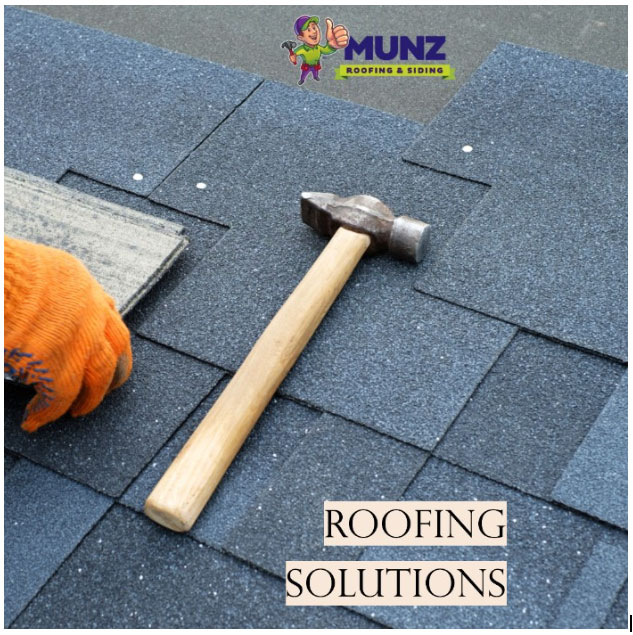The summer season brings warmer temperatures, increased humidity and more UV light – all of which can have a damaging effect on your roof. In 2023, with a strong El Niño in effect, there have already been more extremes than in recent years.
At Munz Roofing & Siding, we understand the importance of roof maintenance in the summer months to ensure your roof stays healthy and undamaged.
What can extreme heat conditions do to residential roofs?
Heat waves can wreak havoc on a vulnerable roof by causing shingle distortion, granule loss, accelerated aging and weakened sealants. To help prevent this damage from occurring, it’s important to regularly inspect your roof for any signs of wear or damage. Look for missing shingles or ones that are distorted or curled; check the gutters for granules that may indicate that your roof has reached its lifespan; and check the sealants around windows, chimneys and other openings to make sure they’re in good shape.
Heat waves can have severe effects on roofs, especially during periods of extreme heat. High temperatures, combined with hot air and high humidity, can put additional strain on roofing materials, particularly asphalt shingles. The intense heat can cause the roof’s surface to rise, leading to cracks, damage, and moisture buildup. New shingles or a brand new roof might be at risk of getting damaged in such conditions.
Roof repair and replacements become common during the summer months as the heat intensifies. Additionally, high winds during hot days can further tear and wear down roofs, exposing them to the elements. Homeowners need to notice any signs of roof damage promptly to access necessary repairs. Ignoring roof issues in a combination of high temperatures and humidity can lead to severe consequences.
For example, heat wave effects on roofs can lead to energy loss, affecting the air conditioning inside the home. With human health at stake, individuals are at risk of experiencing heat exhaustion or heat stroke due to the extreme heat. Rust can also become an issue in roofing materials exposed to severe heat and moisture. To protect their homes and themselves from the hotter and harsher effects of heat waves, homeowners should ensure their roofs are well-maintained and repaired as needed.
Here are some ways that a prolonged heat wave can damage your roof
1. Shingle distortion
Shingle distortion is one of the most common problems that can occur during a prolonged heat wave.
When exposed to high temperatures, asphalt shingles can become soft and begin to buckle or warp. This compromises their waterproofing properties and puts your roof at risk of water damage from rain or snow. Additionally, warping can cause gaps in between the shingles that allow moisture infiltration into your roof system, leading to premature aging and decay. It’s important to inspect your roof for any signs of warped shingles as soon as possible and replace them with new ones.
2. Granule loss
Granule loss is another common problem that can occur during a prolonged heat wave.
Asphalt shingles are made up of a granular composition, and when exposed to high temperatures, the granules can become loose and start to wear away. This can lead to weakening of the shingle which compromises its waterproofing capabilities. Additionally, this granular wear also leads to fading of the roofing material, which reduces the aesthetic appeal of your roof and detracts from its curb appeal. If left unchecked, this type of damage can result in major leaks and expensive repairs down the line. To prevent this from happening, it’s important to regularly inspect your roof for any signs of granule loss and replace damaged shingles as soon as possible. Additionally, installing a cool roof or reflective coating on your existing roof can help reduce temperatures by reflecting UV rays away from your home and keeping it cooler during summer months.
3. Accelerated aging
High temperatures and increased humidity can accelerate the aging process of a roof, leading to weakened materials, cracked sealants and damaged shingles.
The combination of these elements can lead to a decrease in the overall lifespan of the roofing system. UV light from prolonged exposure to sunlight can also increase the rate at which asphalt shingles deteriorate and become brittle. When exposed to UV rays, the organic matter that makes up the shingle can break down quickly, leading to discoloration and fading of the material. With this accelerated aging process, it’s important to inspect your roof regularly for any signs of wear or damage that may indicate it’s time for repairs or replacement.
Thermal shock is another factor that can contribute to accelerated aging in roofs during summer months. Thermal shock occurs when roofs are heated up quickly by direct sunlight and then cooled rapidly due to night temperatures. This often causes expansion and contraction in roof materials which leads to cracking and splitting of shingles or sealants. To prevent this from happening, it’s important to keep an eye on temperature fluctuations in your area and take precautions such as installing a cool roof or reflective coating on your existing roof that will help reduce temperatures by reflecting UV rays away from your home and keeping it cooler during summer months.
4. Weakened sealants
High temperatures and increased humidity during a prolonged heat wave can have a detrimental effect on your roofing sealants.
Sealants are used to bond two roof materials together, such as between shingles, or around chimneys, vents or other openings. When exposed to the heat and humidity of summer months, these sealants can become soft and start to degrade, weakening the bond between the materials they were meant to protect. This can cause water infiltration which can lead to significant damage over time. Additionally, weakened sealants also make it easier for wind-driven rainwater to penetrate through the seams in your roofing system which can result in costly repairs down the line.
To prevent this from happening, it’s important to inspect your roof regularly for any signs of wear or damage that may indicate weakened sealants. If you notice that any of your sealants are cracked or showing signs of age or deterioration, it’s best to replace them with fresh sealant right away before further damage is done. Additionally, you may want to consider installing a cool roof coating which helps reduce temperatures by reflecting UV rays away from your home and keeping it cooler during summer months – this reduces thermal shock which can also weaken the bond between roof materials.
5. Softening of roofing materials
Prolonged heat waves can cause the softening of roofing materials due to the high temperatures and increased humidity.
This often leads to cracking and splitting of shingles or sealants, resulting in weakened waterproofing properties which can cause water infiltration into your roof system. Softening can also result in deformation, such as warping or buckling of shingles, which can lead to gaps between them that allow moisture in. In addition, softening of roofing materials can accelerate the aging process which increases the likelihood of leaks and costly repairs down the line.
To prevent this from happening, it’s important to keep an eye on temperature fluctuations in your area and take precautions such as installing a cool roof coating or reflective material that will help reduce temperatures by reflecting UV rays away from your home. Additionally, regular inspections for signs of wear and tear should be done so that any potential damage can be caught early on before it becomes more serious.
6. Expanding and contracting due to temperature fluctuations
When a prolonged heat wave hits, temperatures can rapidly fluctuate from day to night which can cause the materials of your roof to expand and contract.
This thermal shock caused by extreme temperature changes can weaken the bond between roofing materials such as shingles or sealants, resulting in cracking and splitting which compromises the integrity of your roofing system. The expansion and contraction of roofing materials also causes warping or buckling of shingles which leads to gaps between them that allow moisture in. When left unchecked, this type of damage can lead to water infiltration into your home, causing structural damage and decay over time.
Additionally, expanding and contracting due to temperature fluctuations can accelerate the aging process of a roof, leading to weakened materials, cracked sealants and damaged shingles. This accelerated aging process reduces the lifespan of your roof and increases the likelihood of costly repairs down the line. To prevent this type of damage from occurring it’s important to take precautions such as installing a cool roof coating or reflective material that will help reduce temperatures by reflecting UV rays away from your home. Additionally, regular inspections for signs of wear and tear should be done so that any potential damage can be caught early on before it becomes more serious.
7. Warping and cracking due to excessive heat exposure
When a prolonged heat wave hits, roofs can be exposed to excessive amounts of heat, causing warping and cracking due to the constant expansion and contraction of roofing materials.
This thermal shock caused by extreme changes in temperature weakens the bond between roofing materials such as shingles or sealants, resulting in splitting and cracking which compromises the integrity of your roof structure.
The warping or buckling of shingles caused by excessive heat exposure can also lead to gaps between them that allow moisture in. When left unchecked, this type of damage can lead to water infiltration into your home, causing structural damage and decay over time. Excessive heat exposure can also accelerate the deterioration process of roof materials, weakening them and leading to cracked sealants and damaged shingles. This accelerated aging process reduces the lifespan of your roof and increases the likelihood of costly repairs down the line.
To prevent this type of damage from occurring it’s important to take precautions such as installing a cool roof coating or reflective material that will help reduce temperatures by reflecting UV rays away from your home. Additionally, regular inspections for signs of wear and tear should be done so that any potential damage can be caught early on before it becomes more serious. Munz Roofing & Siding is here to help make sure you stay up-to-date with all necessary repairs or replacements needed for your particular roof and climate conditions during summer months!
8. Discoloration from UV light exposure
Heat waves can wreak havoc on a vulnerable roof, especially when it comes to discoloration from UV light exposure.
The heat generated by the sun during summer months is much stronger than that of the winter months and the UV rays emitted can cause severe damage to roofing materials such as shingles, tiles and other components. This type of damage usually presents itself in the form of fading, cracking and warping which weakens the overall integrity of your roofing system.
Not only does this type of damage reduce your roof’s lifespan, but it also makes it more susceptible to further decay and water infiltration over time. Discoloration from UV light exposure can also lead to accelerated aging of roofing materials which compromise their waterproofing properties and make them prone to wear and tear.
Additionally, weakened sealants due to UV light exposure make it easier for wind-driven rainwater to penetrate through the seams in your roofing system which can result in costly repairs down the line.
To prevent discoloration from UV light exposure it’s important to take precautions such as installing a cool roof coating or reflective material that will help reduce temperatures by reflecting UV rays away from your home. Additionally, regular inspections for signs of wear and tear should be done so that any potential damage can be caught early on before it becomes more serious. Munz Roofing & Siding is here to help make sure you stay up-to-date with all necessary repairs or replacements needed for your particular roof and climate conditions during summer months!
If you find any signs of damage or aging during your inspection, contact Munz Roofing & Siding right away. Our expert team can quickly assess the condition of your roof and provide a cost-effective solution that will keep your home safe from summer weather damage. Don’t neglect your roof this season – contact us today for all your roof maintenance needs!





